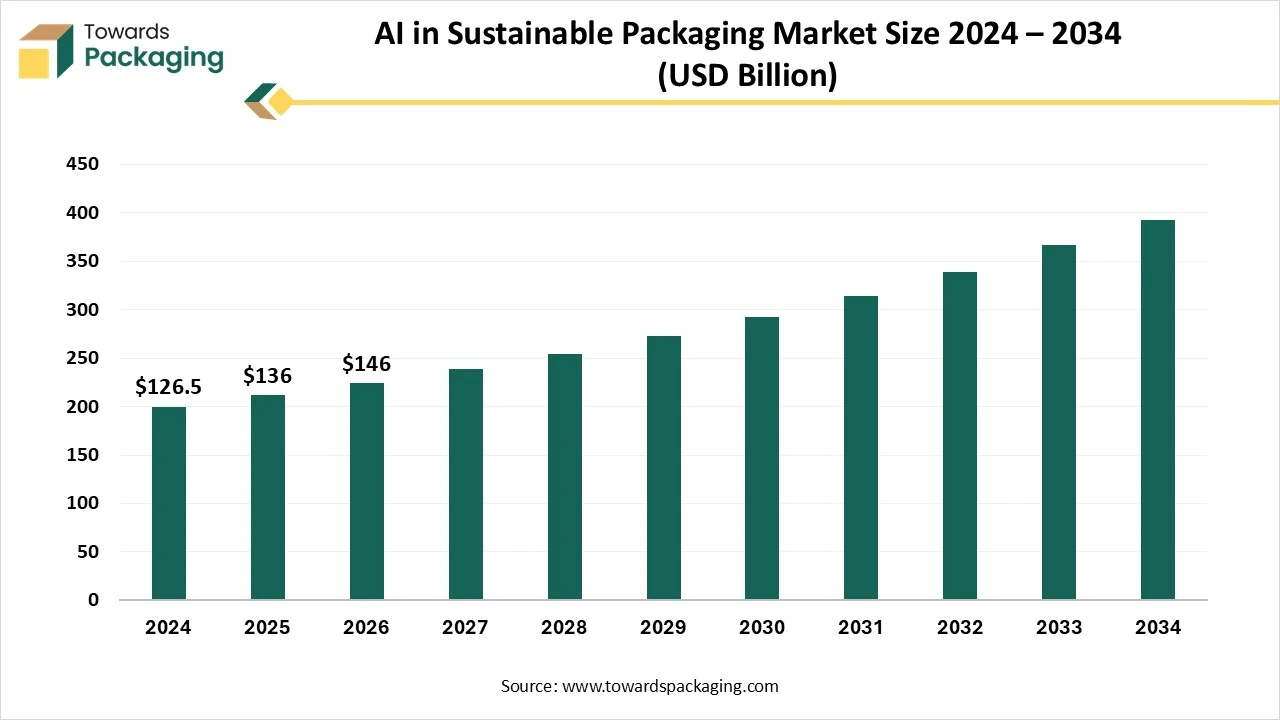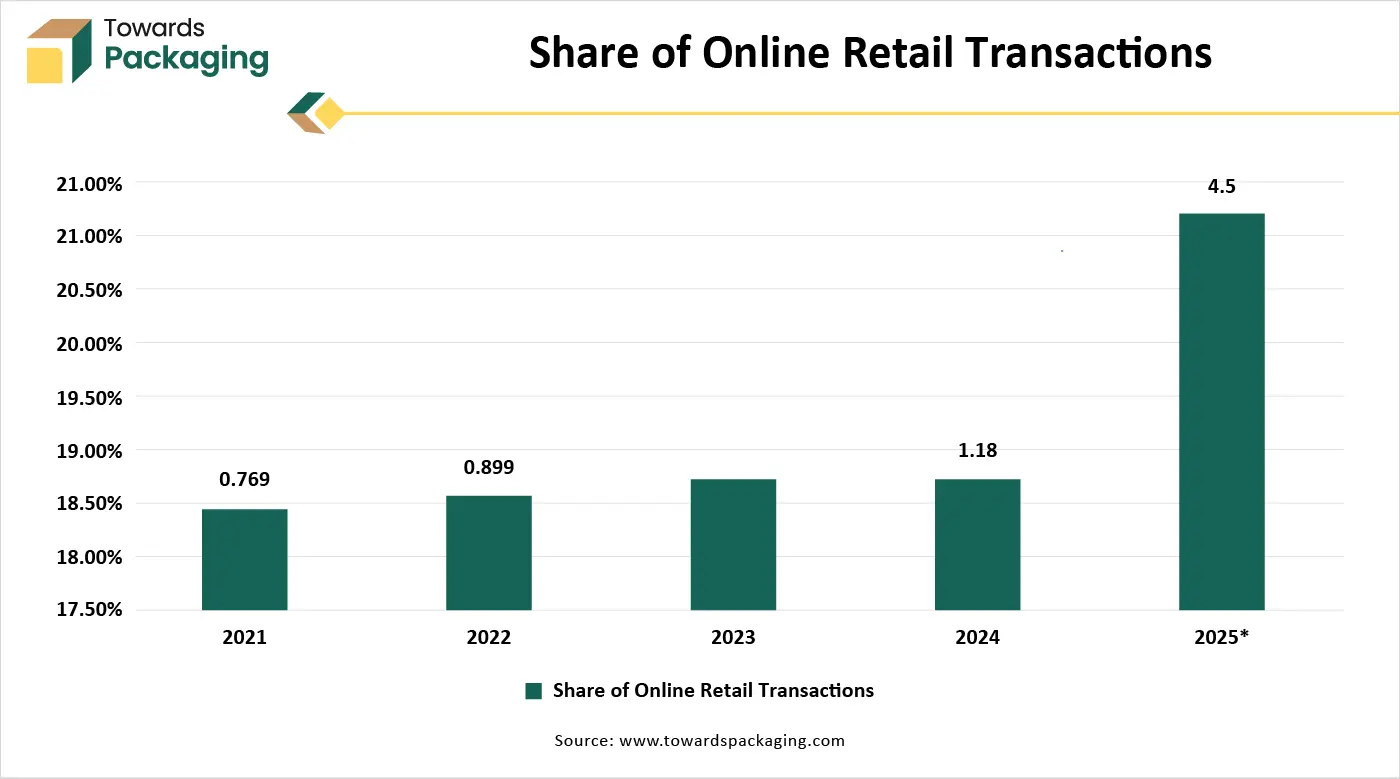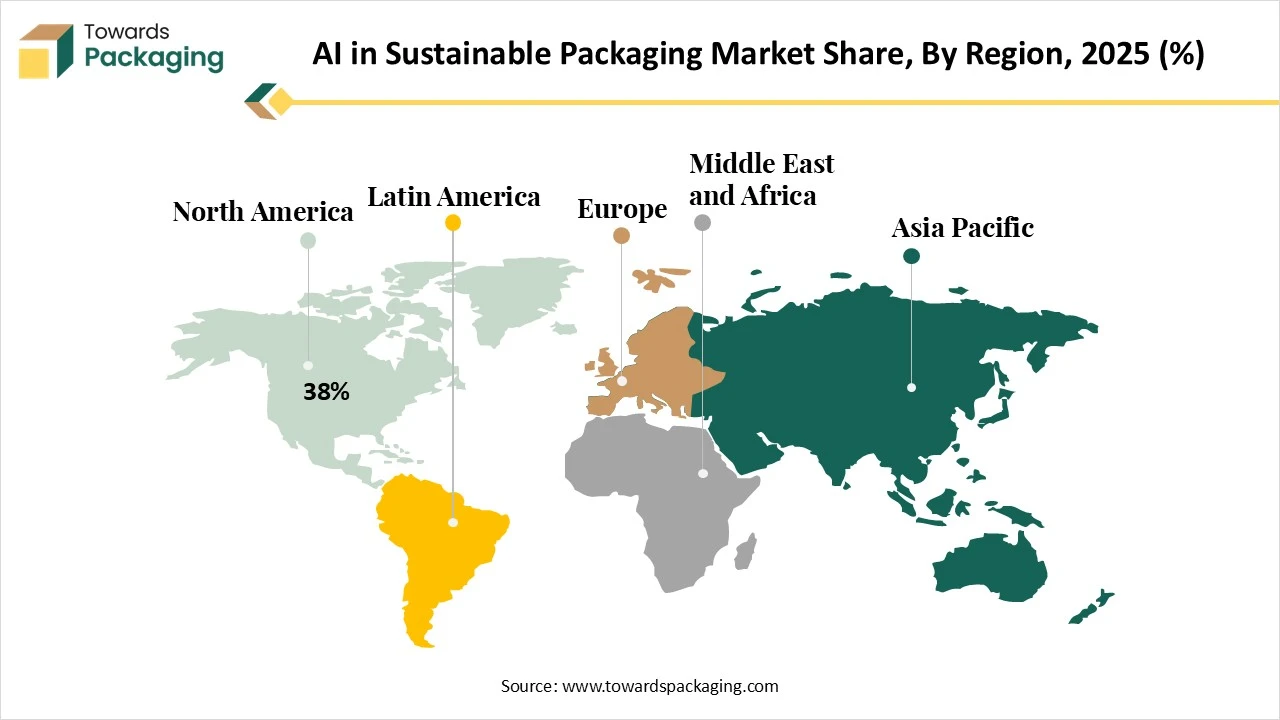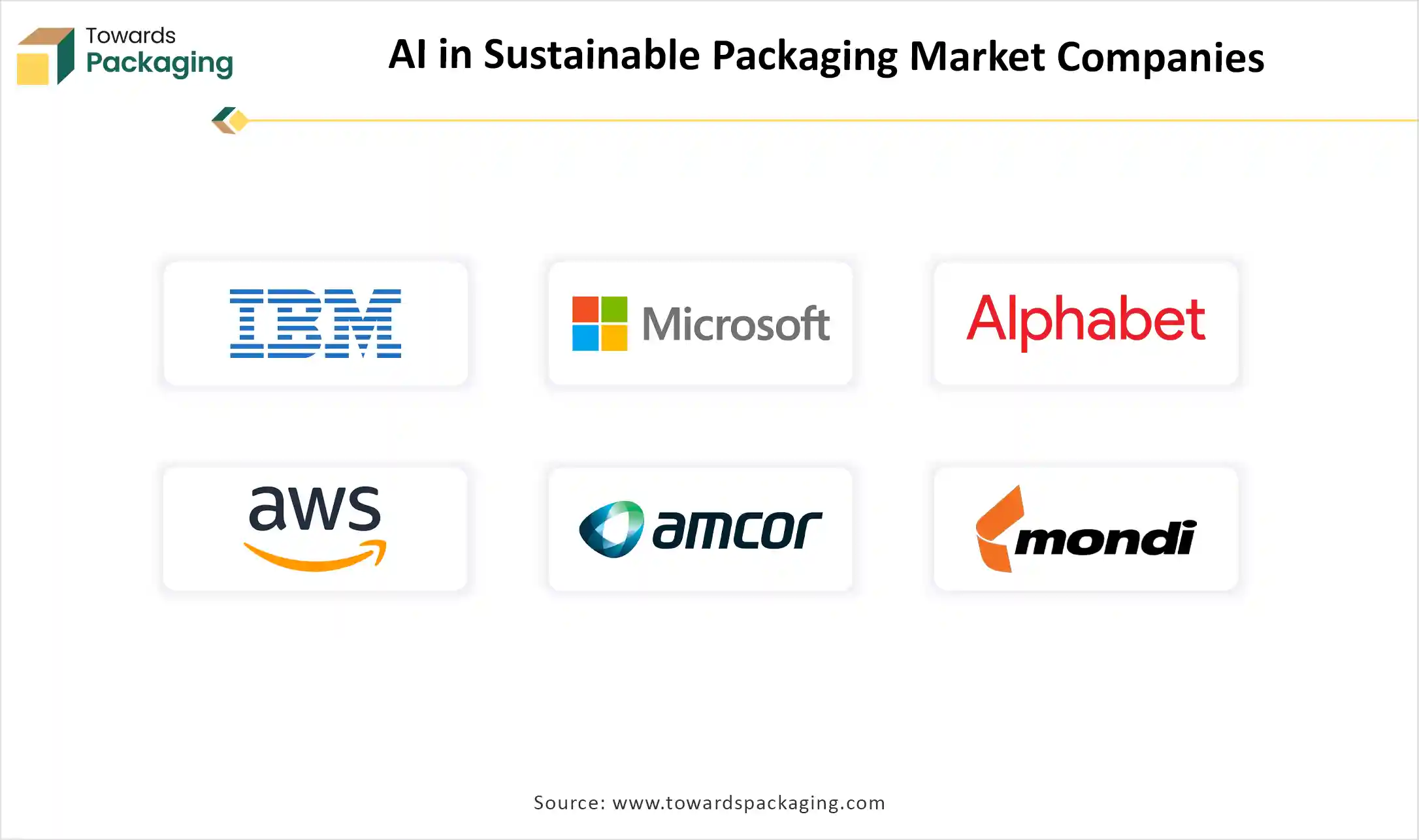November 2025
The global AI in sustainable packaging market is accelerating, with forecasts predicting hundreds of millions in revenue growth between 2025 and 2034, powering sustainable infrastructure globally. The key players operating in the market are focused on adopting inorganic growth strategies like acquisition and merger to develop advance technology for manufacturing sustainable packaging. The market is growing rapidly, driven by increasing demand for eco-friendly solutions and efficiency in production.
AI technologies optimize material usage, reduce waste, and enhance packaging design for recyclability. They also support smart supply chain management and predictive maintenance. Brands are adopting AI to meet sustainability goals and regulatory compliance. Integration of machine learning and computer vision further improves quality control and automation. This market is poised for strong growth across industries like food, beverages, cosmetics, and e-commerce.

AI in sustainable packaging refers to the use of artificial intelligence technologies to develop, optimize, and manage eco-friendly packaging solutions. It involves applying AI tools like machine learning, computer vision, and data analytics to:
| Metric | Details |
| Key Growth Driver | E-commerce Expansion & Automation – AI enables smart, right-sized packaging and logistics efficiency |
| Leading Region | North America |
| Market Segmentation | By AI Technology Type, By Application, By End-Use Industry and By Region |
| Top Key Players | IBM Corporation, Microsoft Corporation, Google (Alphabet Inc.), Amazon Web Services (AWS), Amcor Plc, Mondi Group, DS Smith |
NFC/ RFID sensors, QR codes, and digital tags deliver real-time data on freshness, temperature, and recyclability, boosting consumer transparency and supply chain traceability. Innovations like battery-free, stretchable smart packages monitor spoilage and actively release preservatives, prolonging shelf life (e.g., fish packaging).
Machine learning optimizes material selection, shape, and density to minimize waste and carbon footprint. AI-driven quality control and vision systems detect production defects in real time, reducing waste.
Automated warehouses with AI and robotics improve pack sizing and reduce plastic use while humans collaborate with machines for improved efficiency. Ranpak’s systems, for example, combine computer vision with automation to right-size boxes and minimize materials.
AI-powered recycling facilities use smart sorting to boost recycled material quality and efficiency. New startups and standards are introducing carbon footprint labels and blockchain-backed traceability to inform conscious consumers.
AI supports faster development and testing of sustainable materials (e.g., plant-based, compostable, or edible packaging) through simulation and data analysis.
Plant-sourced packaging (e.g., mushroom mycelium, seaweed, cornstarch, edible millet cups) is gaining traction. AI supports lifecycle analysis and compostability forecasting.
AI integration is revolutionizing the sustainable packaging industry by improving efficiency, reducing waste, and promoting eco-friendly innovation. It enables optimized packaging design by analyzing data to minimize material use while maintaining product integrity. AI also assists in selecting sustainable materials through life cycle analysis, supporting the use of recyclable and biodegradable options. In manufacturing, AI-driven quality control systems detect defects in real time, reducing production errors and waste. It enhances supply chain efficiency by forecasting demand, reducing overproduction, and optimizing logistics. Additionally, AI improves recycling through smart sorting technologies and engages consumers via smart packaging with sustainability information. Overall, AI supports lower carbon emissions and more responsible packaging practices, making it a key driver in achieving sustainability goals across industries.
Expansion of E-Commerce and Logistics
The booming e-commerce sector needs sustainable, right-sized, and efficient packaging to support automation and customization at scale. The growth of e-commerce and logistics is a major driver for the AI-sustainable packaging industry due to several interconnected factors. With the surge in online shopping, there is an increasing need for efficient, lightweight, and eco-friendly packaging to protect goods while minimizing waste. AI helps in designing right-sized packaging, reducing excess material, and lowering shipping costs. It also supports automated packaging systems that improve speed, accuracy, and energy efficiency in fulfillment centers. In logistics, AI optimizes routing, storage, and inventory management, reducing carbon emissions. Additionally, as consumers demand sustainable and smart packaging solutions, brands use AI to enhance product traceability, recyclability, and environmental transparency. Together, these needs fuel innovation and growth in AI-powered sustainable packaging tailored to e-commerce and logistics.

Lack of Technical Expertise and Resistance to Change
The key players operating in the market are facing issues due to data privacy, lack of technical expertise, and resistance to change, which is estimated to restrict the growth of the market. Many packaging companies lack the in-house expertise to develop, operate, and maintain AI-driven systems effectively. In developing regions, poor digital infrastructure and inadequate access to advanced technologies hinder AI adoption.
Adoption of Circular Economy Models
AI can enhance material recovery, reuse, and recycling through smart waste sorting, predictive analysis, and packaging lifecycle tracking. AI enhances this model by enabling smart waste sorting. AI-powered vision systems and robotics improve the separation of recyclable materials, increasing recovery rates and reducing contamination. AI helps to track packaging materials through production, use, and disposal, enabling better material flow and transparency.
The machine learning algorithms segment holds a dominant presence in the market due to its predictive capabilities and customization, and design optimization. Machine learning (ML) excels at analyzing large datasets to forecast demand, optimize packaging design, and reduce overproduction, leading to less waste and more sustainable operations. Machine learning algorithms help to create right-sized, eco-friendly packaging by learning from historical data and consumer trends, minimizing material usage, and improving efficiency. Machine Learning computer vision systems detect defects in packaging in real-time, reducing rework, saving materials, and maintaining consistent sustainability standards. Machine learning aids in identifying recyclable materials, improving waste sorting, and enhancing packaging lifecycle analysis, which aligns with circular economy goals.
The natural language processing (NLP) segment is expected to grow at the fastest rate. Natural Language Processing (NLP) helps manufacturers extract and interpret complex sustainability regulations, packaging standards, and environmental policies across global markets to ensure compliance. NLP enables efficient processing of supplier contracts, sustainability reports, and certifications, helping companies assess environmental risks and select greener vendors. NLP streamlines the generation of ESG and sustainability reports by summarizing vast amounts of internal and external data in clear, report-ready formats. NLP-powered systems improve communication between research and development, design, and compliance teams by extracting insights from technical documents, patents, and industry research.
The packaging design and optimization segment accounted for the dominant revenue share of the AI in sustainable packaging market in 2024. AI algorithms analyze product dimensions, weight, and shipping requirements to create right-sized packaging, reducing excess material use and lowering costs. AL helps design packaging that meets eco-friendly criteria such as recyclability, biodegradability, or minimal carbon footprint, supporting circular economy practices. Machine learning and generative design tools automate and accelerate the packaging design process, reducing time-to-market for new products. AI supports personalized and localized packaging designs, especially useful in e-commerce and marketing, without compromising sustainability or efficiency. By optimizing structure, material choice, and production processes, AI minimizes production waste, transportation costs, and energy use.
The supply chain and logistics segment is expected to grow at the fastest rate in the market during the forecast period of 2025 to 2034. AI analyses historical data, market trends, and real-time signals (e.g., weather, events) to accurately predict product demand, helping avoid overproduction or stockouts. AI systems automate inventory management by determining optimal stock levels, reducing waste, storage costs, and product obsolescence. AI-powered logistics platforms identify the fastest, most fuel-efficient delivery routes, lowering transportation costs and carbon emissions. AI enables smart warehousing through robotics, computer vision, and real-time data analysis, increasing accuracy and reducing labor costs. AI predicts potential disruptions (e.g., supplier delays, geopolitical issues) and suggests alternative sourcing or routing strategies to maintain resilience. AI continuously processes data to support fast, adaptive decisions, especially crucial in global, just-in-time logistics models.
The food and beverages segment dominates the market due to shelf-life optimization and supply chain efficiency. AI helps design packaging that extends product freshness by analyzing temperature, humidity, and spoilage patterns, reducing food waste. AI creates data-driven packaging designs that use minimal material without compromising product protection, supporting sustainability, and cost savings. AI enables intelligent packaging with sensors or QR codes that monitor freshness, track supply chain conditions, and provide recyclability instructions to consumers. AI assists in navigating complex food safety and environmental regulations, ensuring packaging meets both health and sustainability standards. AI improves forecasting, inventory management, and distribution in the food sector, ensuring sustainable packaging is used efficiently and at scale.
The pharmaceuticals and healthcare industry segment is growing rapidly due to rising demand for patient safety and reducing environmental impact. AI ensures accurate dosing and right-sized packaging for medicine, reducing material waste and improving sustainability without compromising safety. AI helps to navigate complex pharmaceutical packaging regulations and sustainability standards, ensuring materials meet environmental and safety criteria globally. AI enables intelligent packaging with features like temperature sensors, tamper detection, and digital instructions, improving patient safety and reducing wastage due to spoilage. AI analyses material performance and environmental performance, and environmental impact to help develop recyclable, biodegradable, or reusable packaging for drugs and medical devices.

North America held the largest share of the AI in sustainable packaging market in 2024, owing to advanced technological infrastructure and the strong presence of key market players. North America, especially the U.S. and Canada, has a well-established AI ecosystem with strong R&D capabilities, advanced manufacturing facilities, and high adoption of Industry 4.0 technologies. Leading packaging, AI, and automation companies are headquartered or operate extensively in North America, accelerating innovation in sustainable packaging solutions. Government policies such as the U.S. Plastic Pact and Canada’s single-use plastics ban push companies toward AI-enabled sustainable practices to meet compliance goals. Corporations in North America are heavily investing in AI to meet ESG targets, reduce their carbon footprint, and adopt circular economy models.
U.S. Market Trends
The U.S. AI in sustainable packaging market is driven by the strong technological infrastructure in the country, widespread use of automation and AI in manufacturing, and the presence of major players like IBM, Microsoft, WestRock, and Amcor. There is significant investment in smart packaging, especially in food, pharmaceuticals, and e-commerce. Additionally, regulatory pressure through the U.S. Plastic Pact and state-level bans on single-use plastics are pushing companies to adopt AI-driven sustainable solutions. The U.S. also sees rising consumer demand for eco-conscious and intelligent packaging, fueling rapid adoption.
Canada Market Trends
Canada is emerging as a key market driven by government initiatives such as the ban on single-use plastics, strong support for the circular economy, and growing awareness among consumers. Canadian companies are increasingly using AI to develop eco-friendly packaging materials, optimize logistics, and reduce food and medical waste. The country benefits from partnerships between research institutions and industries to develop AI-enabled sustainability innovations. Canada’s transparent policy framework and focus on environmental accountability further support market growth.
The Asia Pacific market is expanding rapidly due to the growing due to booming e-commerce and manufacturing sectors in the region. Rapid growth in online shopping and large-scale manufacturing, especially in countries like China, India, and Southeast Asia, drives demand for efficient, eco-friendly packaging solutions that AI can optimize. Regional governments are implementing policies to reduce plastic use and promote circular economy practices, encouraging industries to adopt AI for material optimization and waste reduction. Countries like China, South Korea, Japan, and India are heavily investing in AI and automation, integrating these technologies into packaging design, manufacturing, and logistics. Asia Pacific’s large electronics, food, and pharmaceutical sectors demand sustainable, smart packaging, driving the adoption of AI safety, traceability, and efficiency.
China Market Trends
The Chinese AI in sustainable packaging market is driven by strong government support and environmental regulations. China’s government has implemented strict plastic bans, waste reduction policies, and circular economy initiatives, pushing industries to adopt AI-based solutions for eco-friendly packaging design and material optimization. China is a global hub for AI research, investment, and innovation, with leading companies like Alibaba, Huawei, and Baidu actively developing AI-driven logistics, manufacturing, and packaging technologies. Urban Chinese consumers are increasingly eco-conscious, creating demand for smart, recyclable, and minimalistic packaging. Brands are turning to AI to analyze consumer behaviour and deliver sustainable packaging solutions. China’s status as a global manufacturing powerhouse supports the integration of AI-powered automation in packaging production, enhancing efficiency and reducing waste.
The Europe region is expected to grow at a notable rate in the foreseeable future. Europe leads globally in environmental policy. Initiatives like the European Green Deal, Plastic Strategy, and Extended Produces Responsibility (EPR) force companies to adopt AI to meet recyclability, carbon reduction, and packaging waste targets. Europe leads globally in environmental policy. Initiatives like the European Green Deal, Plastic Strategy, and Extended Producer Responsibility (EPR) force companies to adopt AI to meet recyclability, carbon reduction, and packaging waste targets. European countries actively promote circular economy models, where AI is used for material recovery, smart waste sorting, and lifecycle tracking to minimize environmental impact.

By AI Technology Type
By Application
By End-Use Industry
By Region
November 2025
November 2025
November 2025
November 2025